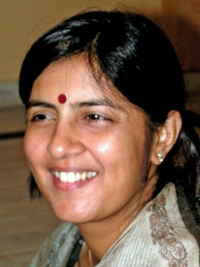Vow Three:
I will not take part in violent agitations or in any destructive activities.
This third vow, once again in the category of ahimsa, reflects another modern social concern in India's pluralistic, post-independence society. When I inquired about the meaning and significance of this vow from my respondents, one female Anuvrati with a PhD in Anekantvada (Jainas doctrine of non-absolutism) responded in the following way:
"The burning of police vehicles or buses on the road, breaking of tables and chairs in the college are a few examples of such violent agitations. It is an outcome of extreme emotional disturbance. Tomorrow these people will need buses to travel and chairs to sit."[95]
Hence, in her opinion, undertaking this kind of vow would at least restrict an individual from voluntary involvement in such destructive activities. In the light of gross violence, it seems my respondents fail to shed light on the widespread prevalent domestic violence against women and children. Even though the vows are marked by the theory of nonviolence, they do not speak about domestic violence.
 Shivani Bothra
Shivani Bothra
